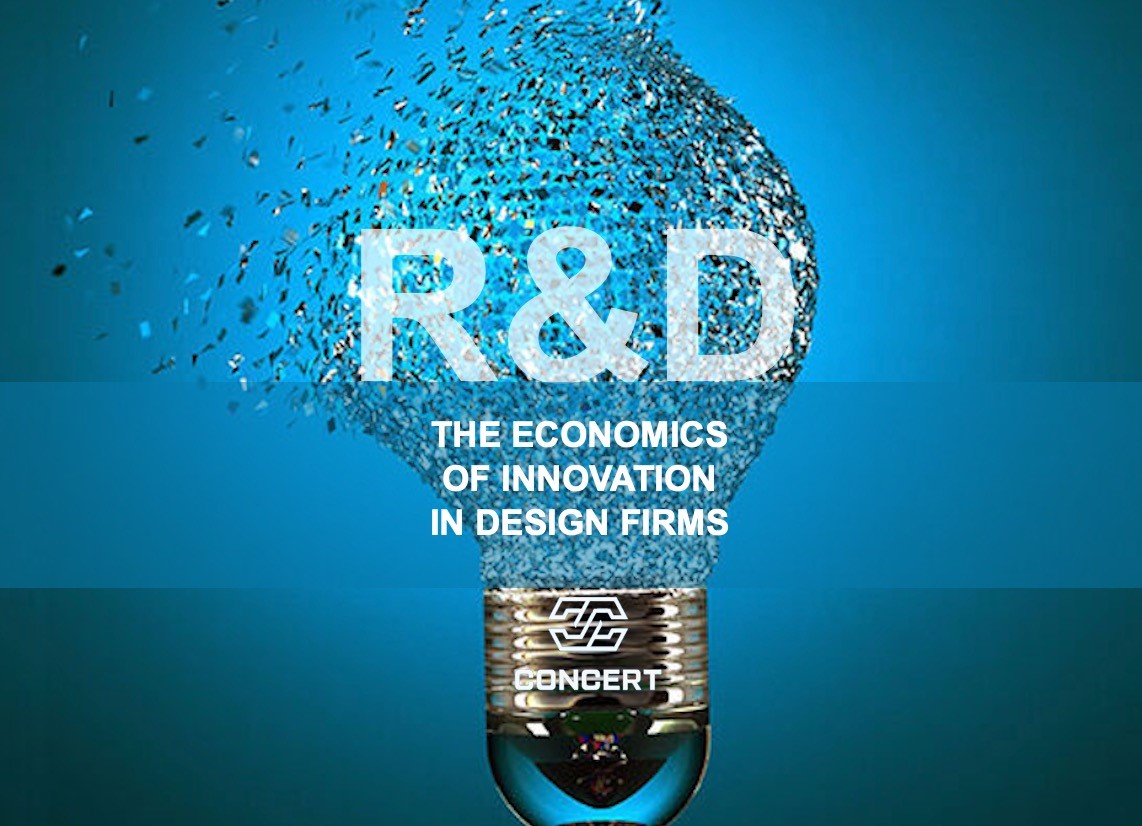by Tim Dufault – Concert CRO
The economic model of professional services limits the capacity of the architectural industry to innovate. Changing the professional services model to generate annual recurring revenue (ARR) would facilitate a more robust investment in R&D to innovate and improve design and building outcomes. Now is the time to change the economic model to create a new model built on innovation and long-term value.
Context
In 2019, US companies spent an average of 4.4% of their income from net sales on R&D. For non-manufacturers, the percentage was 3.8%. Large architectural firms, in contrast, spent less than 1% of their net income on R&D activities because of other demands on their resources. Firms that have achieved scale (generally over $50M in revenue) can start to leverage some of their overhead investment towards R&D. Still, the efforts usually need to be fully funded and come from non-billable time performed by billable staff. This is not a sustainable model. Nevertheless, large firms (over $100M in revenue) generated enough net income to support full-time R & D activities that might achieve marketable results. Other models have emerged, including research consortiums where firms pool their resources to fund research in areas of common interest. Regardless of the model, current research activities by architecture firms have yet to generate industry-wide innovation.
THE PROBLEM
How do you incentivize innovation in a design firm? One would think that by the very nature of the practice, there would always be a focus on innovating. However, architecture is structured as a professional service – your client has a business problem, and they hire your firm to design a solution and a construction firm to build it. In a professional service model, the value of your service is equated with time, with more experienced staff billed at the highest rates. The rate charged is a multiple of the individual’s salary + benefits + overhead + profit. In general, the industry aims to charge at least 3.2 X the salary for everyone in the company (billable and unbillable), ideally. However, when time is the only value you provide, there is always pressure to reduce the time allocation as a mechanism to reduce input costs.
On virtually every project, in small ways, the design team brings creative ideas of using, installing, or manipulating everyday materials in unique applications. These little “explorations” sometimes lead to very real and scalable innovations for the entire industry. Those are easy innovations because they come primarily from minimal investments of time or resources, and their uses are focused on the project, which is billable. But what about larger innovations that change the core systems of a building? How might we create fundamental change in the entire ecosystem of design and construction? For larger questions like these, innovating inside the design firm becomes difficult, even cost prohibitive.
A WAY FORWARD
So how can the architecture industry become a more active innovator? By changing the fundamental economic model of the practice – shift the focus from being a provider of design services to creating life-cycle value for the building owner. What would this model look like?
We’ve written on this in the past, but the summary is to charge for the value of data creation, use, and management, not the hours on a timesheet. Then, leverage that data to provide greater value for the building owner through digital management services that maintain the data currency over time. This requires a shift in thinking from architectural design as a service (hours) to architectural design as a product (data). The longer-term value of the data would create a more consistent income stream for the firm and therefore create a more manageable mechanism to fund R&D activities – but only if it provides longer-term value for the building owner. With a consistent source of income and access to an ongoing stream of performance data, the opportunity to innovate in the industry will expand exponentially.
CONCERT AS EVIDENCE OF POTENTIAL
Concert is a platform focused on innovating the design and construction industry. We firmly believe greater value can be created across the industry by focusing on the data created in the process. Capturing the value of that data requires everyone in the industry to build their capacity to innovate. Yet to innovate, the industry must commit to changing the economic model and the management processes that depend on the data created by each party. This is the chicken or egg dilemma; neither can come first, and both require each other to exist.





